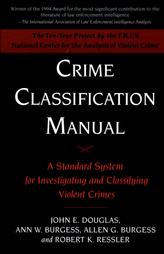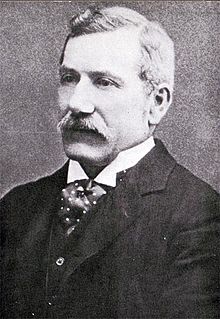
A serial killer is typically a person who murders three or more people, with the murders taking place over more than a month and including a significant period of time between them. While most authorities set a threshold of three murders, others extend it to four or lessen it to two.
Geographic profiling is a criminal investigative methodology that analyzes the locations of a connected series of crimes to determine the most probable area of offender residence. By incorporating both qualitative and quantitative methods, it assists in understanding spatial behaviour of an offender and focusing the investigation to a smaller area of the community. Typically used in cases of serial murder or rape, the technique helps police detectives prioritize information in large-scale major crime investigations that often involve hundreds or thousands of suspects and tips.
The National Center for the Analysis of Violent Crime (NCAVC) is a specialist FBI department. The NCAVC's role is to coordinate investigative and operational support functions, criminological research, and training in order to provide assistance to federal, state, local, and foreign law enforcement agencies investigating unusual or repetitive violent crimes.
The Behavioral Analysis Unit (BAU) is a department of the Federal Bureau of Investigation's National Center for the Analysis of Violent Crime (NCAVC) that uses behavioral analysts to assist in criminal investigations. The mission of the NCAVC and the BAU is to provide behavioral based investigative and/or operational support by applying case experience, research, and training to complex and time-sensitive crimes, typically involving acts or threats of violence.

Robert K. Ressler was an FBI agent and author. He played a significant role in the psychological profiling of violent offenders in the 1970s and is often credited with coining the term "serial killer", though the term is a direct translation of the German term "Serienmörder" coined in 1930 by Berlin investigator Ernst Gennat. After retiring from the FBI, he authored a number of books on serial murders, and often gave lectures on criminology.

In criminology, a disorganized offender is a type of serial killer classified by unorganized and spontaneous acts of violence. The distinction between "organized" and "disorganized" offenders was drawn by the American criminologist Roy Hazelwood. These profiles were also studied and modified in the FBI's Behavioral Science Unit located in Quantico, Virginia. By classifying these offenders into different categories, the FBI is able to track down offenders by studying their behavior and habits.
The Violent Criminal Apprehension Program (ViCAP) is a unit of the United States Federal Bureau of Investigation responsible for the analysis of serial violent and sexual crimes, based in the Critical Incident Response Group's (CIRG) National Center for the Analysis of Violent Crime (NCAVC).

Offender profiling, also known as criminal profiling, is an investigative strategy used by law enforcement agencies to identify likely suspects and has been used by investigators to link cases that may have been committed by the same perpetrator. Multiple crimes may be linked to a specific offender and the profile may be used to predict the identified offender's future actions.

John Edward Douglas is an American retired special agent and unit chief in the United States Federal Bureau of Investigation (FBI). He was one of the first criminal profilers and has written and co-written books on criminal psychology, true crime novels, and his biography.
The FBI method of profiling is a system created by the Federal Bureau of Investigation (FBI) used to detect and classify the major personality and behavioral characteristics of an individual based upon analysis of the crime or crimes the person committed. One of the first American profilers was FBI agent John E. Douglas, who was also instrumental in developing the behavioral science method of law enforcement.
The Morgan P. Hardiman Child Abduction and Serial Murder Investigative Resources Center (CASMIRC) is part of the National Center for the Analysis of Violent Crime (NCAVC). CASMIRC was established as part of Public Law 105-314, the Protection of Children From Sexual Predators Act, passed by Congress on October 30, 1998. The legislation creates the center to reduce crime involving child abductions, mysterious disappearances of children, child homicide, and serial murder.
Gregg O. McCrary is a former FBI agent who served from 1969 to 1995, an expert witness and consultant, an author and an adjunct forensic psychology professor at Nova Southeastern University in Fort Lauderdale, and at Marymount University in Arlington, Virginia. McCrary was a contributing author to the 1992 Crime Classification Manual.
Patrick Joseph Mullany was an American Federal Bureau of Investigation special agent and instructor at the FBI Academy. He is best known for pioneering the FBI's offender profiling in the 1970s and 1980s with fellow FBI instructor Howard Teten. Mullany received a master's degree in psychology and counseling from Manhattan College. He began working for the FBI in the mid-1960s. His primary position in the FBI was in the Behavioral Analysis Unit, where he embarked on his work in offender profiling. Mullany applied methods to analyze possible patterns of behavior and traits common in certain types of criminals. In doing this, the FBI can attempt to narrow down suspects and predict future likelihood of offending.
Howard Duane Teten was an American Federal Bureau of Investigation agent and an instructor at the FBI Academy. While in the FBI, he worked in criminal profiling, also known as offender profiling with the help of Patrick Mullany. Teten and Mullany used this tool to attempt to identify unknown perpetrators. From the classes that Teten and Mullany taught at the FBI Academy, they helped form the Behavioral Health Science Unit and developed offender profiling, which is still used today.

Crime Classification Manual: A Standard System for Investigating and Classifying Violent Crimes (1992) is a text on the classification of violent crimes by John E. Douglas, Ann W. Burgess, Allen G. Burgess and Robert K. Ressler. The publication is a result of a project by the Federal Bureau of Investigation's National Center for the Analysis of Violent Crime.

David J. Icove is a former Federal Bureau of Investigation Criminal Profiler and FBI Academy Instructor in the elite Behavioral Analysis Unit. He was one of the FBI's first criminal profilers to specialize in the apprehension of serial arsonists and bombers. He is Fellow in the National Academy of Forensic Engineers and co-author along with Gerald A. Haynes of Kirk's Fire Investigation, the leading textbook in the field of fire investigation.
A serial rapist is someone who commits multiple rapes, whether with multiple victims or a single victim repeatedly over a period of time. Some serial rapists target children. The terms sexual predator, repeat rape and multiple offending can also be used to describe the activities of those who commit a number of consecutive rapes, but remain unprosecuted when self-reported in research. Others will commit their assaults in prisons. In some instances, a group of serial rapists will work together. These rapists can have a pattern of behavior that is sometimes used to predict their activities and aid in their arrest and conviction. Serial rapists also differ from one time offenders because "serial rapists more often involved kidnapping, verbally and physically threatening the victims, and using or threatening the use of weapons."
Mindhunter is an American psychological crime thriller television series created by Joe Penhall, which debuted in 2017, based on the 1995 true-crime book Mindhunter: Inside the FBI's Elite Serial Crime Unit by John E. Douglas and Mark Olshaker. The executive producers include Penhall, Charlize Theron, and David Fincher, the latter of whom has served as the series' most frequent director and de facto showrunner, overseeing many of the scriptwriting and production processes. The series stars Jonathan Groff, Holt McCallany, and Anna Torv, and it follows the founding of the Behavioral Science Unit in the Federal Bureau of Investigation (FBI) in the late 1970s and the beginning of criminal profiling.
James R. Fitzgerald is an American criminal profiler, forensic linguist, and author. He is a retired FBI agent and best known for his role in the UNABOM investigation, which resulted in the arrest and conviction of Ted Kaczynski.

A Journey to the Center of the Mind (JCM) is a book series authored by James R. Fitzgerald, retired FBI agent, criminal profiler and forensic linguist. The series, published by Infinity Publishing between 2014 and 2017, consists of three volumes detailing chronologically the life and career circumstances that led to Jim Fitzgerald's involvement in the FBI's UNABOM investigation, which ultimately resulted in the arrest and prosecution of Theodore Kaczinski, also known as the Unabomber.










